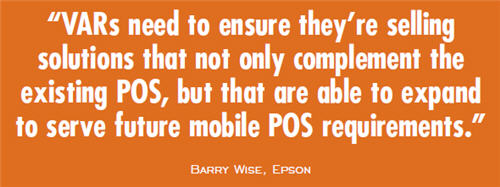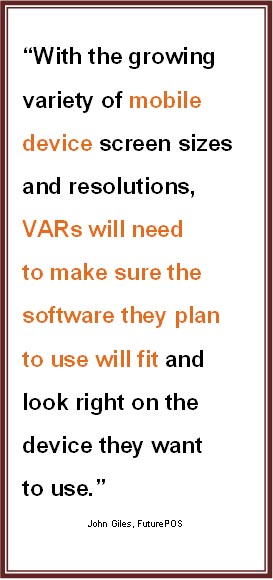Ring Up New Sales With Mobile POS
By Brian Albright, Business Solutions magazine
New technology complements existing POS solutions, providing VARs an opportunity for follow-on sales and services.

Mobile POS solutions are already a familiar part of customer transactions at ballparks and airports across the country, and now those same solutions are expanding into traditional retail outlets and restaurants. According to IHL Consulting, by 2015 more than 2.7 million tablets a year will be sold to retailers for use as mobile POS devices and consumer information tools. Consumers, already familiar with smartphone and tablet interfaces, are increasingly asking for more opportunities to use mobility solutions while they shop.
So, how can POS VARs take advantage of this opportunity? And, does mobile POS pose a threat to existing POS business? “Regardless of the application, industry, or market, users want a POS solution in their hand or in their pocket for immediate, convenient access,” says Gus Reid, VP of sales and marketing at Partner Tech. “The VAR needs to offer mobile versions of its current solutions as well as new, complementary mobile solutions. This is a very exciting opportunity.”
Early adopters will likely be found among specialty retailers with specific goals for customer service differentiation. “It can be particularly beneficial where higher levels of customer service are already part of a retailer’s DNA,” says Barry Wise, senior marketing consultant at Epson America. “For example, high-end department stores that already know customer preferences can really enhance service by going the extra mile to provide that customer with product and inventory information or to complete a customer transaction wherever the customer happens to be in the store.”
Integrated Software Solutions, Rugged Hardware
While VARs have to be prepared to offer mobile solutions, they also need to understand how each solution fits within the vertical they sell. Not everything mobile necessarily fits into every market.
“Case in point: Mobile POS is likely more appealing, and certainly more applicable, to a restaurant than it is to a general retail store,” says Lee Harville, VP of channel sales for Sundrop Mobile. “However, other mobile solutions like mobile loyalty and marketing are generally in demand across most verticals. Basically, they need to focus on core mobile solutions in demand by their clients and ones with which they feel comfortable.”
It’s important for VARs to approach mobile POS with a long view toward making these systems one part of a more holistic POS offering. “VARs should look for software solutions that extend and enhance existing POS functionality, rather than something that operates as a separate application,” Wise says. “VARs need to ensure they’re selling solutions that not only complement the existing POS, but that are able to expand to serve future mobile POS requirements.”
Hardware selection is also critical; these devices are likely to be handled roughly and exposed to liquids, particularly in restaurants or even some retail applications such as home improvement. “Durability, ruggedness, serviceability, and the warranty should all be serious considerations,” Reid says. “And, for many applications, integrated peripherals including MSRs (magnetic stripe readers) and scanners will be very important parts of the solution. Software should be extensively tested with each specific device, and pilot installations should be well-tested before every significant rollout.”

Many end users are interested in deploying solutions on consumer hardware like the iPad, and VARs have to be prepared to either offer solutions on these platforms or have compelling arguments against using nonrugged devices. “The risks would be that they aren’t rugged and would have the potential to be used for nonwork-related purposes,” says John Giles, president of Future POS. “If you have a traditional handheld, you don’t have an app store or a Web browser to distract employees. In restaurants, grease and moisture are also a concern, and these ‘throwaway’ devices may end up needing to be replaced far more often than is cost-effective.”
But, Wise says that theft and replacement cost issues can be addressed, if the platform is a fit for the application. “There are apps out there for next to nothing that safeguard the devices, like GPS chips and programs that shut the device down if it’s removed from a designated area,” he says. “Then, there’s the argument that the devices are not rugged enough for harsh retail and restaurant environments, which is being addressed by the myriad of rugged add-ons available to protect the device.”
The primary challenge in deploying a mobile POS solution at an existing location will be ensuring adequate wireless bandwidth and that the wireless LAN is sufficiently secure to transmit payment data. “Wireless connectivity is a big problem when retrofitting existing businesses for mobile solutions,” Giles says. “Also, with the growing variety of mobile device screen sizes and resolutions, VARs will need to make sure the software they plan to use will fit and look right on the device they want to use.”
If the VAR is offering other types of mobile solutions to the retailer, such as mobile marketing or loyalty solutions, Harville warns that you may wind up dealing with multiple departments within the same customer organization. “In many cases, your sales person may need to speak with a different person regarding mobile marketing,” Harville says. “POS is many times sold to IT or operations and comes from their budget, but mobile marketing needs to be sold to the marketing department, which in many cases may have a larger separate budget.”
Mobility Complements Traditional POS
What impact will mobile POS have on existing POS business? The vendors interviewed for this story agree that mobility will complement, not compete with, traditional POS solutions. VARs have an opportunity to sell more peripherals (like wireless printers), as well as new software that can be integrated with existing POS systems. “Mobile solution offerings provide the VAR new opportunities to leverage their existing infrastructure to generate additional revenues, more profits, and more satisfied customers using the ‘coolest’ of dependable, beneficial new technology,” Reid says.
One possible downside would be widespread adoption of consumer-grade mobile devices, such as the iPad, which could eat into margins. “Clearly there is a shift toward these technologies, and there is a general buzz about things new and exciting,” Giles says. “Still, these mainstream devices have yet to prove their long-term viability with regard to durability and serviceability. If they prove to be cost-effective, VARs will have to find other revenue streams, as hardware will shrink significantly when the customer can purchase these items readily on the Internet for the lowest price possible.”

More importantly, as merchants expand their mobility initiatives to include POS along with loyalty, marketing, and other types of systems, VARs can help them leverage these new connections with customers to generate useful data that can be used to increase sales and customer retention. “We are now seeing a paradigm shift in that the merchant wants and needs to know more about their consumers,” Harville says. “Having this information allows merchants to target their consumers based on specific criteria, which can increase ROI for their marketing dollars. As a VAR with the relationship and confidence of the client, this creates a tremendous opportunity to become the expert in this field.”
